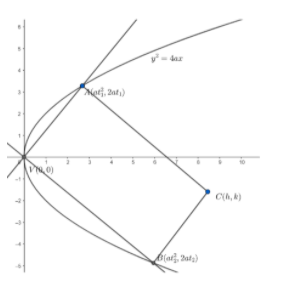Answer
34.5k+ views
Hint: The mid-points of the diagonals of a rectangle are the same .
Let’s take the equation of parabola as \[{{y}^{2}}=4ax\].
We know the vertex of this parabola is at \[V\left( 0,0 \right)\].
Let \[A\left( at_{1}^{2},2a{{t}_{1}} \right)\] and \[B\left( at_{2}^{2},2a{{t}_{2}} \right)\] be the two vertices of the rectangle.

Now, we are given that the two chords are perpendicular.
We know that if two lines are perpendicular to each other , then the product of their slopes is equal to \[-1\].
So, slope of \[VA\times \] slope of \[VB=-1\]
Now , we will find the slope of \[VA\] and slope of \[VB\].
We know , the slope of the line joining two points \[({{x}_{1}},{{y}_{1}})\] and \[({{x}_{2}},{{y}_{2}})\] is given as \[m=\dfrac{{{y}_{2}}-{{y}_{1}}}{{{x}_{2}}-{{x}_{1}}}\].
So , slope of \[VA=\dfrac{2a{{t}_{1}}-0}{at_{1}^{2}-0}=\dfrac{2}{{{t}_{1}}}\]
And , slope of \[\text{ }VB=\dfrac{2a{{t}_{2}}-0}{at_{2}^{2}-0}=\dfrac{2}{{{t}_{2}}}\]
So, \[\dfrac{2}{{{t}_{1}}}\times \dfrac{2}{{{t}_{2}}}=-1\]
\[\Rightarrow {{t}_{1}}{{t}_{2}}=-4....\left( i \right)\]
We need to find the locus of further vertex.
So , we will consider the further vertex to be \[C\left( h,k \right)\].
Now , in the question it is given that \[AVBC\] is a rectangle.
We know the diagonals of a rectangle bisect each other.
So , midpoint of \[AB=\] midpoint of \[\text{ }VC.....(ii)\]
Now, we will find the midpoints of \[AB\] and \[VC\].
Midpoint of
\[\text{ }AB=\left( \dfrac{at_{1}^{2}+at_{2}^{2}}{2},\dfrac{2a{{t}_{1}}+2a{{t}_{2}}}{2} \right)\]
\[=\left( \dfrac{at_{1}^{2}+at_{2}^{2}}{2},a{{t}_{1}}+a{{t}_{2}} \right)....\left( iii \right)\]
Midpoint of \[\text{ VC}=\left( \dfrac{h+0}{2},\dfrac{k+0}{2} \right)\]
\[=\left( \dfrac{h}{2},\dfrac{k}{2} \right).....\left( iv \right)\]
From \[\left( ii \right),\left( iii \right)\]and \[\left( iv \right)\], we can say
\[\dfrac{h}{2}=\dfrac{at_{1}^{2}+at_{2}^{2}}{2}\] and \[\dfrac{k}{2}=a{{t}_{1}}+a{{t}_{2}}\]
Now, \[\dfrac{h}{2}=\dfrac{at_{1}^{2}+at_{2}^{2}}{2}\]
\[\Rightarrow t_{1}^{2}+t_{2}^{2}=\dfrac{h}{a}....\left( v \right)\]
and \[\dfrac{k}{2}=\left( a{{t}_{1}}+a{{t}_{2}} \right)\]
\[\Rightarrow {{t}_{1}}+{{t}_{2}}=\dfrac{k}{2a}.....\left( vi \right)\]
Squaring both sides we get
\[t_{1}^{2}+t_{2}^{2}+2{{t}_{1}}{{t}_{2}}=\dfrac{{{k}^{2}}}{4{{a}^{2}}}.....\left( vii \right)\]
From equation \[\left( i \right),\left( v \right)\]and \[\left( vii \right)\]
\[\dfrac{h}{a}-8=\dfrac{{{k}^{2}}}{4{{a}^{2}}}\]
or \[{{k}^{2}}=4a\left( h-8a \right)\]…….equation\[(viii)\]
Now, to find the locus of \[C\left( h,k \right)\], we will substitute \[(x,y)\] in place of \[\left( h,k \right)\] in equation \[(viii)\]
So, the locus of \[C\left( h,k \right)\] is given as \[{{y}^{2}}=4a\left( x-8a \right)\]
Note: While simplifying the equations , please make sure that sign mistakes do not occur. These mistakes are very common and can cause confusions while solving. Ultimately the answer becomes wrong. So, sign conventions should be carefully taken .
Let’s take the equation of parabola as \[{{y}^{2}}=4ax\].
We know the vertex of this parabola is at \[V\left( 0,0 \right)\].
Let \[A\left( at_{1}^{2},2a{{t}_{1}} \right)\] and \[B\left( at_{2}^{2},2a{{t}_{2}} \right)\] be the two vertices of the rectangle.

Now, we are given that the two chords are perpendicular.
We know that if two lines are perpendicular to each other , then the product of their slopes is equal to \[-1\].
So, slope of \[VA\times \] slope of \[VB=-1\]
Now , we will find the slope of \[VA\] and slope of \[VB\].
We know , the slope of the line joining two points \[({{x}_{1}},{{y}_{1}})\] and \[({{x}_{2}},{{y}_{2}})\] is given as \[m=\dfrac{{{y}_{2}}-{{y}_{1}}}{{{x}_{2}}-{{x}_{1}}}\].
So , slope of \[VA=\dfrac{2a{{t}_{1}}-0}{at_{1}^{2}-0}=\dfrac{2}{{{t}_{1}}}\]
And , slope of \[\text{ }VB=\dfrac{2a{{t}_{2}}-0}{at_{2}^{2}-0}=\dfrac{2}{{{t}_{2}}}\]
So, \[\dfrac{2}{{{t}_{1}}}\times \dfrac{2}{{{t}_{2}}}=-1\]
\[\Rightarrow {{t}_{1}}{{t}_{2}}=-4....\left( i \right)\]
We need to find the locus of further vertex.
So , we will consider the further vertex to be \[C\left( h,k \right)\].
Now , in the question it is given that \[AVBC\] is a rectangle.
We know the diagonals of a rectangle bisect each other.
So , midpoint of \[AB=\] midpoint of \[\text{ }VC.....(ii)\]
Now, we will find the midpoints of \[AB\] and \[VC\].
Midpoint of
\[\text{ }AB=\left( \dfrac{at_{1}^{2}+at_{2}^{2}}{2},\dfrac{2a{{t}_{1}}+2a{{t}_{2}}}{2} \right)\]
\[=\left( \dfrac{at_{1}^{2}+at_{2}^{2}}{2},a{{t}_{1}}+a{{t}_{2}} \right)....\left( iii \right)\]
Midpoint of \[\text{ VC}=\left( \dfrac{h+0}{2},\dfrac{k+0}{2} \right)\]
\[=\left( \dfrac{h}{2},\dfrac{k}{2} \right).....\left( iv \right)\]
From \[\left( ii \right),\left( iii \right)\]and \[\left( iv \right)\], we can say
\[\dfrac{h}{2}=\dfrac{at_{1}^{2}+at_{2}^{2}}{2}\] and \[\dfrac{k}{2}=a{{t}_{1}}+a{{t}_{2}}\]
Now, \[\dfrac{h}{2}=\dfrac{at_{1}^{2}+at_{2}^{2}}{2}\]
\[\Rightarrow t_{1}^{2}+t_{2}^{2}=\dfrac{h}{a}....\left( v \right)\]
and \[\dfrac{k}{2}=\left( a{{t}_{1}}+a{{t}_{2}} \right)\]
\[\Rightarrow {{t}_{1}}+{{t}_{2}}=\dfrac{k}{2a}.....\left( vi \right)\]
Squaring both sides we get
\[t_{1}^{2}+t_{2}^{2}+2{{t}_{1}}{{t}_{2}}=\dfrac{{{k}^{2}}}{4{{a}^{2}}}.....\left( vii \right)\]
From equation \[\left( i \right),\left( v \right)\]and \[\left( vii \right)\]
\[\dfrac{h}{a}-8=\dfrac{{{k}^{2}}}{4{{a}^{2}}}\]
or \[{{k}^{2}}=4a\left( h-8a \right)\]…….equation\[(viii)\]
Now, to find the locus of \[C\left( h,k \right)\], we will substitute \[(x,y)\] in place of \[\left( h,k \right)\] in equation \[(viii)\]
So, the locus of \[C\left( h,k \right)\] is given as \[{{y}^{2}}=4a\left( x-8a \right)\]
Note: While simplifying the equations , please make sure that sign mistakes do not occur. These mistakes are very common and can cause confusions while solving. Ultimately the answer becomes wrong. So, sign conventions should be carefully taken .
Recently Updated Pages
To get a maximum current in an external resistance class 1 physics JEE_Main

f a body travels with constant acceleration which of class 1 physics JEE_Main

If the beams of electrons and protons move parallel class 1 physics JEE_Main

Let f be a twice differentiable such that fleft x rightfleft class 11 maths JEE_Main

Find the points of intersection of the tangents at class 11 maths JEE_Main

For the two circles x2+y216 and x2+y22y0 there isare class 11 maths JEE_Main

Other Pages
A planoconvex lens f20cm is silvered at the plane surface class 12 physics JEE_Main

Differentiate between homogeneous and heterogeneous class 12 chemistry JEE_Main

Two identical charged spheres suspended from a common class 12 physics JEE_Main

The resultant of vec A and vec B is perpendicular to class 11 physics JEE_Main

Iodoform can be prepared from all except A Acetaldehyde class 12 chemistry JEE_Main

If a wire of resistance R is stretched to double of class 12 physics JEE_Main



